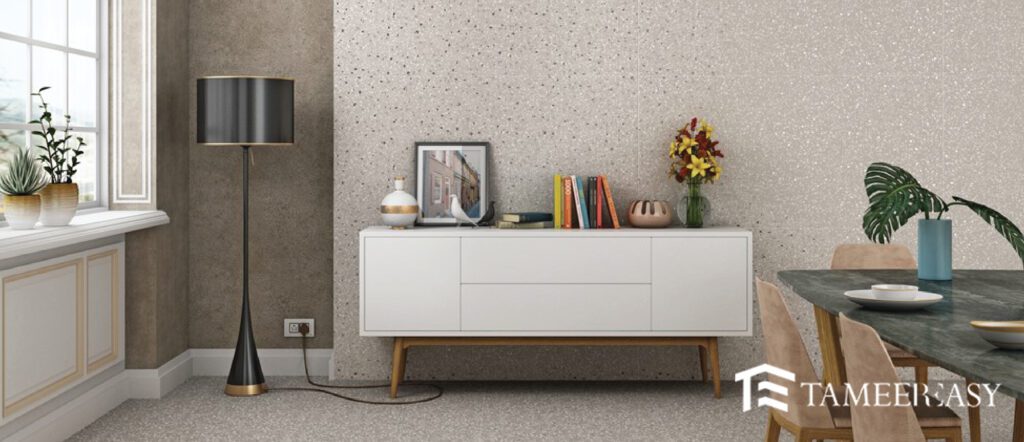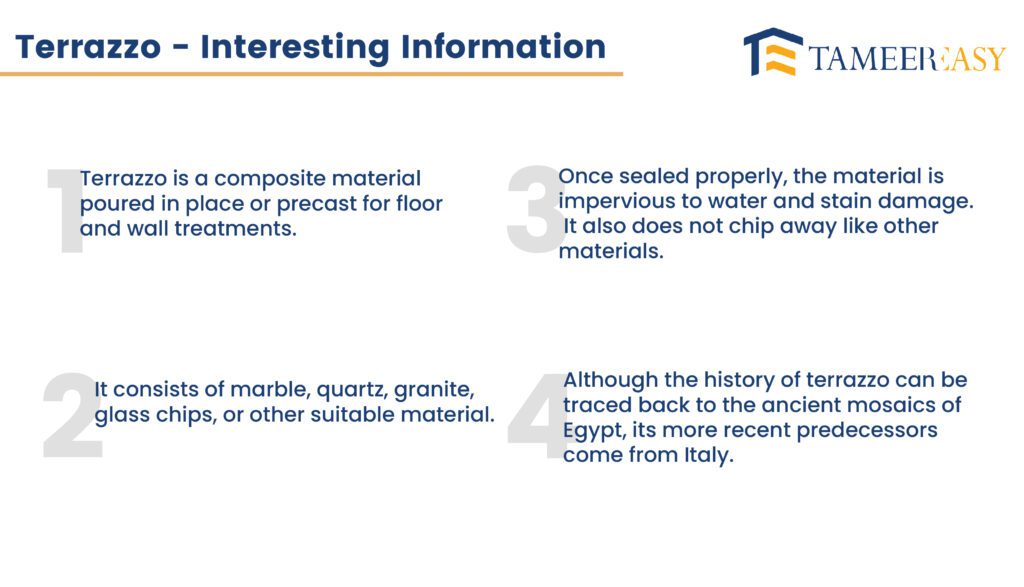You may have seen carpeted flooring and probably know it’s durable. But did you know it’s called Terrazzo flooring in construction?
Visit TameerEasy Store to Purchase Quality Construction Items
This article will explore what materials are used, where they are commonly applied, and what considerations are essential before installation.

What is Terrazzo Flooring
‘Terrazzo’ is an Italian term derived from ‘Terrace.’ Initially, it was made from waste materials of marble or granite, where larger pieces were arranged in a matrix, ranging from 1/8 inch to a quarter-inch in size. These pieces were mixed with cement. This was the starting point of Terrazzo flooring, which evolved with various variations over time.
Terrazzo is a composite material that can be cast in situ or pre-cast. It is commonly used for flooring and walls. It can incorporate chips or fragments of marble, granite, glass, or other suitable materials.
Typically, it involves a uniform mixture of cementitious binders, a combination of polymers, or both. Besides marble and granite chips, various stones can create unique designs or patterns within Terrazzo.
Types of Terrazzo Floors
Terrazzo floors can come in two types: Pre-Cast and Cast In Situ. If it’s pre-cast, we refer to it as Terrazzo tiles. When it’s cast in situ, it’s known as Terrazzo flooring. As you now understand, Terrazzo is a composite material made from chips or fragments of materials like marble, granite, glass, or quartz.
Initially, Terrazzo started with Egyptian mosaic and later became popular for flooring. That’s why we sometimes call Terrazzo floors’ Mosaic floors.
Ingredients of Terrazzo
Typically, for the finishing of Terrazzo floors, we take two components. One part consists of marble chips, quartz, or any material you choose to use, and the other part involves cement, which acts as the binder material. Water is then added to this dry volume to create a homogenous mixture. Depending on the desired form, this mixture is applied as Terrazzo flooring, cast in situ, or pre-cast.
The thickness of this layer ranges from half an inch to a full inch. Beneath it, the floor base is typically a concrete mix in a 1:4 proportion, which can vary from one and a half inches to two and three-quarters of an inch. Before it completely dries, usually within 6 to 8 hours, we lay this layer, ranging from half an inch to three-quarters of an inch, on panels or forms. This is how we apply Terrazzo flooring cast in situ.
In another method, we lay our 1:4 concrete mix and then spread fragments of marble or granite on top. This allows these fragments to embed within the concrete.


Process of Applying Terrazzo
The process is relatively straightforward.
- First, a base floor is constructed, commonly called rough flooring. Depending on the desired depth of the floor, typically ranging from 1.5 to 2.5 inches, we use a 1:4 concrete mix.
- We often employ divider strips to accommodate the design, pattern, or panel size.
- These strips can be made of various materials like marble, glass, aluminum, brass, or copper, and their top aligns with the top level of the final floor.
- Next, leaving a gap ranging from half an inch to ¾ of an inch, we lay the concrete on top after the initial set. This is where we create mosaic flooring.
- After laying, we cure it with watering for two to three days.
- Following this, the initial cutting occurs around five to six days later. During the cutting process, the floor surface becomes uniform and smooth.
- This process is also known as grinding. Grinding and cutting are repeated two to three times, resulting in around eight to ten steps.
- Finally, the floor is polished.
Purpose of Terrazzo Flooring
- The most important factor in Terrazzo flooring is its durability; it’s incredibly long-lasting. It provides a long-lasting finish.
- Second, it offers the advantage of achieving various aesthetic and architectural looks. You can create different designs and patterns on your floor, including flower petals, blocks, and other designs.
- Moreover, we have various shades of colors available. Normally, it’s done in grey or white, but you can also add your preferred pigment.
- To give you an idea, for every 40 kilograms of cement in a bag, we add 250 grams of pigment. This means that you get your desired shade for every half a pound of pigment added.
- The lifespan of Terrazzo flooring is so long that if, after five to seven years, you feel that the floor doesn’t look as good as it used to, you can lightly grind and polish it. This will give it a fresh look once again.
Different Types of Terrazzo Floors?
There are four types of terrazzo floor:
- Epoxy terrazzo
- Sand cushion terrazzo
- Bonded terrazzo
- Monolithic terrazzo
Additionally, there is polyacrylate Terrazzo, which includes polymers. The most commonly used types are bonded Terrazzo and monolithic Terrazzo.
Is it Only Used for Walls and Floor?
The Terrazzo floor is weather-resistant and waterproof, similar to how it is cast. Instead of using various coatings for waterproofing, like you often see in underground water tanks of houses, terrazzo flooring is applied to walls and floors. This type of Terrazzo is known as “steel trap finish terrazzo,” it functions as a waterproof material.
Similarly, tiles and other materials are now used in the laundry rooms’ interiors. Previously, a specific height of composite material was used to create Terrazzo on the inner walls of laundry rooms. The advantage of this was that the quarter-inch or three-quarter-inch layers applied worked like waterproofing material.
Benefits of Terrazzo Flooring
- The most significant advantage of terrazzo flooring is its versatility, as it can be used indoors and outdoors.
- Another benefit is its limited water absorption capability, which makes it resistant to bacteria and similar issues, thus keeping homes safe.
- When properly maintained, Terrazzo can handle substantial weight loads. Its strength is typically around 4500 psi and is highly resistant to heat, which is why it’s used for backsplashes in kitchen countertops around stoves and ovens.
Drawbacks of Terrazzo Flooring
- One significant drawback is that terrazzo flooring can be quite expensive due to the labor-intensive process of laying it.
- It’s a lengthy and time-consuming procedure.
- After installation, it requires drying time, followed by grinding and polishing.
- In contrast, regular tiles can be used within two to three days after application.
- Another common term for Terrazzo is “cold flooring.” If you insulate underneath the layer of Terrazzo, it can remain cool in the winter. However, this feature can be a drawback during hot summer months.
What are Terrazzo Tiles?
Terrazzo tiles are typically pre-cast and come in various sizes, ranging from 12×12 inches, 6×12 inches, to 12×18 inches, with the maximum size reaching up to two feet. They have a thickness of one inch, with the lower half-inch consisting of a 1:4 concrete mix, while the upper half-inch features the terrazzo composite material.
This composite material includes marble or quartz aggregates and cement. If color is desired, pigment is added to the mix.
These pre-cast tiles are manufactured using machines to ensure proper compaction. Afterward, they undergo a curing period of about four to five days. Once the tiles are set, they are either machine-ground or subjected to the initial cutting process, typically carried out on a separate pre-casting plant.
After about five to seven days have passed, similar to the process for regular terrazzo flooring, they undergo grinding and polishing.
Durability of Terrazzo
Terrazzo flooring typically has a lifespan of up to a hundred years. If you visit old houses and buildings in Lahore city, you’ll often find terrazzo or mosaic flooring. Even today, these floors can be seen in their original form, retaining their timeless appearance.
Closing Remarks
We hope you now understand what terrazzo flooring is and how it is used. If you still need further guidance or have any questions on this topic, please visit our website, “tameereasy.”







